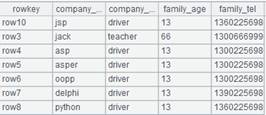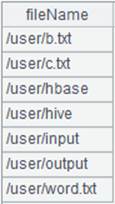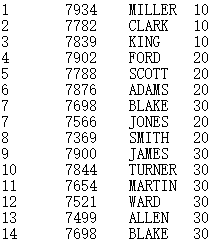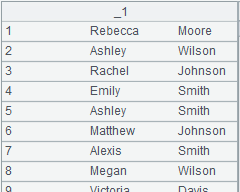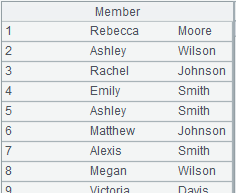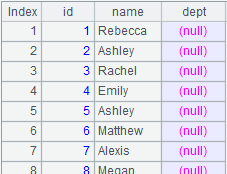S.import()
Description:
Retrieve contents from strings as records and return them as a table sequence.
Syntax:
S.import(Fi:type;fmt,…;s)
Note:
The function retrieves specified or all fields from string S and returns them as a table sequence.
Parameter:
|
S |
A string. Format: separate the records by line break, and the fields by user-defined separator; the default separator is tab |
|
Fi |
Fields to be retrieved; by default, all fields will be retrieved |
|
type |
Field types include bool, int, long, float, decimal, number, string, date, time and datetime; data type of the first row will be used by default; it is a serial byte key. when the value is an integer; only 16 bytes are allowed in a serial byte value |
|
fmt |
Date\time format |
|
s |
User-defined separator; the default is tab |
Option:
|
@t |
Take the first row in f as the field name. If not using this option, then use _1, and _2,… as the field name |
|
@c |
Use comma as the separator when parameter s is absent |
|
@s |
Won’t split strings and data will be imported as a table sequence consisting of strings of single field values; and ignore parameters |
|
@i |
Return the result set as a sequence if it only contains one field |
|
@q |
Remove the quotation marks, if any, from both ends of data items, including the field names, and handle escape sequences; but will keep quotation marks within the data item |
|
@a |
Treat single quotes as what they are; left not handled by default, and can work with @q@p |
|
@o |
Perform escaping according to the Excel rule, which identifies two double quotation marks as one and does not escape the other characters |
|
@p |
Enable handling the matching of parentheses (not including the separators within the parentheses) and quotes, as well as the escape sequences outside of the quotes |
|
@f |
Split the file content into a string by the separator without parsing |
|
@l |
Allow line continuation and put an escape character \ at the end the line |
|
@k |
Retain white spaces on both sides of the data item; without it, white spaces on both ends will be automatically deleted |
|
@e |
Generate null if parameter Fi isn’t included in the imported strings; by default, there will be an error report |
|
@d |
Delete a record if it contains unmatching data types or data formats and start examining data by type, or if the parentheses and the quotation marks in it do not match when @p option and @q option respectively are present |
|
@n |
Ignore a row whose number of columns don’t match the first row |
|
@v
|
In corporation with @d or @n, if a mismatch appears, throw an exception, terminate the execution and output the content of the problem record |
|
@w |
Read each row, including the column headers row, as a sequence and return a sequence of sequences |
|
@r |
Read contents as a string before parsing so that errors about some character sets can be avoided; the option slows the computation |
Return value:
Table sequence
Example:
|
|
A |
|
|
1 |
=demo.query("select * from EMPLOYEE") |
|
|
2 |
=A1.(~.array().concat@c()) |
Convert to the sequence of strings.
|
|
3 |
=A2(1).import(;",") |
Select all fields from a specified string in the sequence. Specify comma as the separator, and return a table sequence as the result. |
|
4 |
=demo.query("select EID,NAME,SURNAME from EMPLOYEE") |
|
|
5 |
=A4.export() |
|
|
6 |
=A4.export@t(EID:id,NAME:name,SURNAME:surname;"|") |
|
|
7 |
=A5.import() |
No parameters are given. The default separator will be tab, and _1 and _2,… will be used as field names. |
|
8 |
=A6.import@t(id:int,name;"|") |
Select fields id and name, separated by “|” . |
|
9 |
=A6.import@f() |
With @f option, just split the file as a string using the separator.
|
|
10 |
1,2,"3,3",(4,4),[5,5],'6,6' |
|
|
11 |
=A10.import@c() |
With @c option, the default separator is the comma.
|
|
12 |
=A10.import@cp() |
With @p option, parentheses and quotation marks matching will be handled during parsing.
|
|
13 |
=A10.import@cpa() |
With @a option, single quotation marks are treated as quotation marks.
|
|
14 |
=A2(1).import@c() |
With @c option, use comma as the default separator. |
|
15 |
=A5.import@s() |
With @s option, won’t split strings and records are imported as a single-field table sequence. |
|
16 |
=A5.import@si() |
A single-field result set will be returned as a sequence. |
|
17 |
"uy'd'uj" |
|
|
18 |
=A17.import() |
|
|
19 |
=A17.import@q() |
With @q option, double quotations will be removed before generating the final table sequence With @q option, first remove quotation marks at both ends of each data item (not handling those within) and then convert data into a table sequence.
|
|
20 |
f1,f2,f3 2,"dd""ff",3 |
|
|
21 |
=A20.import@coq() |
With @o option, two double quotation marks in one string are treated as one.
|
|
22 |
=" abc ".import@k() |
Retain the whitespaces on boths sides. |
|
23 |
=A6.import@te(id:int,name,dept;"|") |
Generate null since dept doesn’t exist in the imported strings. |
|
24 |
id|name|surname a|Rebecca|Moore 2|Ashley|Wilson 3|Rachel|Johnson 4|Emily|Smith 5|Ashley|Smith 6|Matthew|Johnson 7|Alexis|Smith 8|Megan|Wilson |
|
|
25 |
=A24.import@td(id:int,name;"|") |
Delete the record as it contains unmatching data types. |
|
26 |
=A24.import@tvd(id:int,name;"|") |
Check data type matching, and, if error reports, throw an exception, terminate the execution and output the content of the problem record; the error message is: Error in cell A26.
|
|
27 |
id|name|surname 1|Rebecca|Moore 2|Ashley 3|Rachel|Johnson 4|Emily |
|
|
28 |
=A27.import@tdn(id:int,name,surname;"|") |
Ignore row 2 and row 3 because the number of columns don’t match that of the table sequence.
|
|
29 |
=A24.import@w(;"|") |
Use @w option to read each row as sequecne of sequences.
|
|
30 |
11,22,"3",\ 33,44,55, 66,77,88 |
|
|
31 |
=A30.import@l() |
With @1 option, allow line continuation when there is an escape character at the end of the line.
|
Related function:
